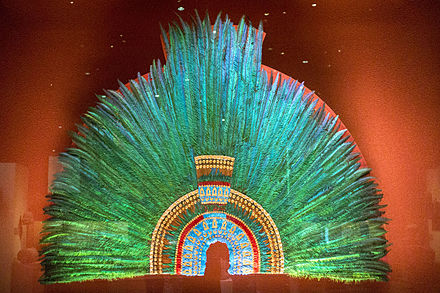Montezuma's headdress
| Moctezuma's headdress | |
|---|---|
.jpg/440px-Moctezuma's_feather_headdress,_ca._1515,_Mexico;_Weltmuseum,_Vienna_(3).jpg) | |
| Material | Feathers of quetzal, Lovely cotinga, Roseate spoonbill, Piaya cayana, gold |
| Size | 116 cm (46 in) high, 175 cm (69 in) diameter |
| Present location | Museum of Ethnology, Vienna, Austria |
| Identification | 10402VO |

Moctezuma's headdress is a featherwork headdress or military device (Nahuatl languages: quetzalāpanecayōtl [ketsalaːpaneˈkajoːtɬ]) which tradition holds belonged to Moctezuma II, the Aztec emperor at the time of the Spanish conquest. However, its provenance is uncertain,[2] and even its identity as a headdress has been questioned.[3] It is made of quetzal and other feathers with sewn-on gold detailing. It is now in the Weltmuseum Wien, and is a source of dispute between Austria and Mexico, as no similar pieces remain in Mexico.
Description
The feathers of the piece have deteriorated over the centuries. It is 116 cm (46 in) high and 175 cm (69 in) across and has the form of concentric layers of different colored feathers arranged in a semicircle. The smallest is made from blue feathers of the Cotinga amabilis (xiuhtōtōtl) with small plates of gold in the shapes of half moons. Behind this is a layer of Roseate spoonbill (tlāuhquechōlli) feathers, then small quetzal feathers, then a layer of white-tipped red-brown feathers of the squirrel cuckoo, Piaya cayana, with three bands of small gold plates, and finally two of 400 closely spaced quetzal tail feathers, some 55 cm (22 in) long. The quetzal feathers in the center of the headdress are raised relative to the sides. Leather straps attach the crown to the head of the wearer.
Though it likely served as a headdress, it has also been identified in other ways. As a headdress, its appearance matches that which is seen in contemporary Aztec codices being worn by priests during the festival of Xocotlhuetzi. However, its appearance also matches that of other kinds of objects also seen in contemporary depictions. In Codex Cozcatzin, emperor Axayácatl is depicted during the Battle of Tlatelolco wearing a quetzal-feathered battle standard and some sort of large device in the back, both of which have a similar appearance. In all situations, it appears that the object is associated with the deity Quetzalcoatl. Regardless, there is no direct evidence which suggests that it actually belonged to Moctezuma.[1]
History

Although attributed to Moctezuma and the Spanish conquest, the provenance of the piece is unattested, and it does not match Aztec illustrations of the headdress of their nobility. It became an object of interest to European researchers such as Ferdinand von Hochstetter and Eduard Seler at the end of the 19th century, and its identification as a quetzalapanecayotl is attributed to American anthropologist Zelia Nuttall.[4] It was restored in 1878, while still thought to be a mantle rather than a headdress. It is attested since 1575 in the collections of Archduke Ferdinand[5] in Ambras Castle near Innsbruck, Austria. At the beginning of the 19th century it was deposited in the Museum of Ethnology (inventory number 10402VO) in Vienna along with other ceremonial artifacts of Quetzalcoatl and Ehecatl.
Although artifact exchanges and restitution of the headdress were negotiated with the Mexican government, a bilateral expert commission deemed the artifact too fragile for transport and thus recommended its remaining in Vienna.[6] In 2020, the Mexican government asked again for the restitution of the headdress.[7]
See also
- Xokonoschtletl Gómora — Mexican activist who has struggled for the return of Moctezuma's headdress.
References
- ^ a b Olko, Justyna (2014). Insignia of Rank in the Nahua World: From the Fifteenth to the Seventeenth Century. University Press of Colorado. pp. 37–38, 128–130, 181. ISBN 9781607322412.
- ^ Johnson, Kayla (2021-08-17). "Austria Should Repatriate the Mexica Headdress". Hyperallergic. Retrieved 2024-04-12.
- ^ Rodríguez, Ana Mónica. "El penacho de Moctezuma es una capa de sacerdote, afirma un investigador", La Jornada, versión electrónica Archived 2009-06-08 at the Wayback Machine
- ^ Zelia Nuttall:Sur le quetzal-apanecaiotl ou coiffure Mexicaine en plumes conservée à Vienne. En: Congrès International des Américanistes, Paris 1890. Paris 1892. S. 453-459
- ^ "Mexico and Austria in dispute over Aztec headdress". prehist.org. 22 November 2012. Archived from the original on 29 November 2014. Retrieved 24 November 2012.
- ^ Corona, Sonia (2014-07-02). "El frágil penacho de Moctezuma". El País (in Spanish). ISSN 1134-6582. Retrieved 2022-08-05.
- ^ "Cómo terminó en Austria el penacho de Moctezuma que AMLO reclama al país europeo". BBC News Mundo (in Spanish). Retrieved 2024-04-12.
External links
- Propuesta de trueque histórico por el Penacho
- "El penacho de Moctezuma es un atavío para la cabeza", nota de prensa emitida por el Conaculta
- "El penacho de Moctezuma es una capa de sacerdote, afirma un investigador", a letter in the journal La Jornada
- "Discutirá el Parlamento de Austria si devuelve el penacho de Moctezuma", in the journal La Jornada
- "Ve Austria difícil devolver penacho de Moctezuma", on Esmas.com
- "¿De quien es el penacho de Moctezuma?", by Carmen Cook de Leonard
- http://www.yankuikanahuak.o-f.com/Xoko.htm
- http://www.thehistoryblog.com/archives/16445